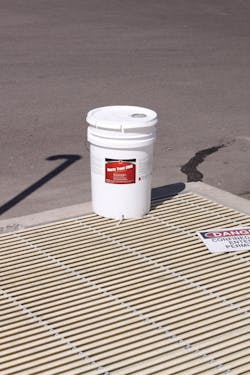About the author: Jeffery Schone is chief of environmental quality for Luke Air Force Base. Schone can be reached at [email protected].
Luke Air Force Base (LAFB) in Glendale, Ariz., has improved its traditional methods of managing POL (petroleum, oil and lubricant)-contaminated wastewater, in partnership with Continental Research Corp. for bioremediation. Through equalized distribution of bacteria into oil-water separators, holding tanks and grease traps, LAFB has achieved full sustainability of wastewater and eliminated pump-and-treat methods.
The bacteria injection of the Bacto-Treat OWS (oil-water separator) was initiated in October 2013, and the results documented over the first year were impressive. By tackling wastewater with a 360-degree approach using the oil-water separator and ND-365 bacterial dosage system, wastewater compliance was made easy and sustainable and achieved cost savings.
Oil-Water Separation
Bioremediation is a process that speeds up the separation of oil and water and degrades potentially harmful POL contaminants. The bacteria chemical is injected at the generation point to encourage digestion of POLs (hydrocarbons) and grease (fats). Through active bacteria reproduction, the bacteria digests the contaminants to produce clean water, sustained infrastructure, improved wastewater treatment plant (WWTP) influent and harmless gases.
Once the water has passed through the bioremediation system, it is transferred to the LAFB water treatment facility for further processing. Due to the effectiveness of the treatment method, LAFB reclassified reuse capabilities to an A+ with the Arizona Department of Environmental Quality for expanded redistribution of non-potable water for dust control.
Overall, the initiative proved effective. Primary benefits included:
- Reduced maintenance on pipe, pumps and associated infrastructure;
- Significant cost reduction of pumping and transport of contaminated water;
- Reduction of maintenance man-hours;
- Reconditioning and restoration of infrastructure and equipment capabilities;
- Complementary reduction of wastewater analytics;
- Reduction of nitrates at WWTP to less than 1 mg/L;
- Significant reduction of grease at lift stations; and
- Automatic injection to maintain optimal bacteria levels and service life.
As highlighted in Figure 1, bioremediation using the OWS has demonstrated an efficient and cost-effective solution for Luke AFB. Pumping was reduced from 175,926 to 7,440 gal from October 2013 to October 2014.
Cost Savings & Emission Reduction
Additional benefits included a reduction in associated man-hours where actual reported time dropped from 98 to 2.5 hours. Overall, LAFB has realized an 80% overall cost savings. Other benefits realized (not calculated) included significant emission reductions from pumping trucks and cost avoidance for maintenance and repair of aged infrastructure. Many of the service lines are 20-plus years old and incur flow and backup issues.
After six months of the treatment, associated piping and pump equipment was cleaned and restored to initial design capabilities. LAFB also was able to measure actual POL degradation at a 14,000-gal OWS, based on initial chemical specifications.
In summary, the bioremediation treatments have proven successful. Luke AFB is expanding the program to add additional complementary applications at sewer lift stations and car washes.
Based on the results of this study, other entities or stakeholders could benefit from bacterial synthesis to introduce fully sustainable wastewater and economically feasible uses. These may include car washes, vehicle maintenance, restaurant grease traps and sewer lift stations.
Download: Here
